11-4 The first missions to Venus and Mars demolished decades of speculations about those planets
Prior to the 1960s, scientists developed a number of intriguing ideas about Venus and Mars. While these ideas were consistent with observations made using Earth-based telescopes, they needed to be radically revised with the advent of spacecraft data.
Speculations About Venus: A Lush Tropical Paradise?
Venus was once thought to be steamy and tropical, and Mars was thought to have vegetation that varied with the seasons
Venus is bathed in more intense sunlight than Earth because it is closer to the Sun. If Venus had no atmosphere, and if its surface had an albedo like that of Mercury or the Moon, heating by the Sun would bring its surface temperature to around 45°C (113°F)—comparable to that found in the hottest regions on Earth. What was unclear until the 1960s was how much effect Venus’s atmosphere has on the planet’s surface temperature.
We saw in Section 9-1 that gases such as water vapor (H2O) and carbon dioxide (CO2) in Earth’s atmosphere trap some of the infrared radiation that is emitted from our planet’s surface. This trapped radiation elevates the temperatures of both the atmosphere and its surface, a phenomenon called the greenhouse effect. In 1932, Walter S. Adams and Theodore Dunham Jr. at the Mount Wilson Observatory found absorption lines of CO2 in the spectrum of sunlight reflected from Venus, indicating that carbon dioxide is also present in the Venusian atmosphere. (Section 7-3 describes how astronomers use spectroscopy to determine the chemical compositions of atmospheres.) Thus, Venus’s surface, like Earth’s, should be warmed by the greenhouse effect.
However, Venus’s perpetual cloud cover reflects back into space a substantial amount of the solar energy reaching the planet. This effect by itself acts to cool Venus’s surface, just as clouds in our atmosphere can make overcast days cooler than sunny days. Some scientists suspected that this cooling kept the greenhouse effect in check, leaving Venus with surface temperatures below the boiling point of water. Venus might then have warm oceans and possibly even life in the form of tropical vegetation. But if the greenhouse effect were strong enough, surface temperatures could be so high that any liquid water would boil away. Then Venus would have a dry, desertlike surface with no oceans, lakes, or rivers.
Close-Up Observations of Venus: Revealing a Broiled Planet
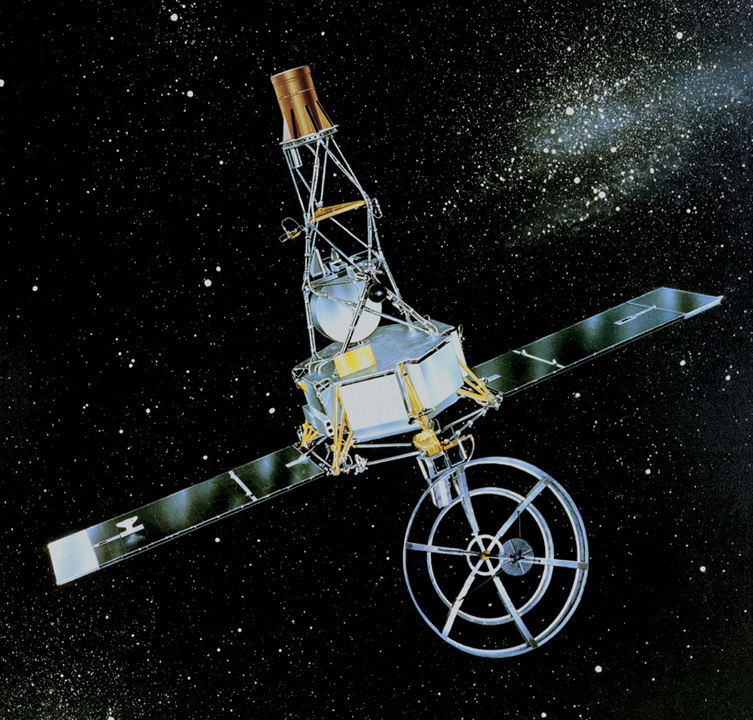
This scientific controversy was resolved in 1962 when the unmanned U.S. spacecraft Mariner 2 (Figure 11-11) made the first close flyby of Venus. As we learned in Section 5-3 and Section 5-4, a dense object (like a planet’s surface) emits radiation whose intensity and spectrum depend on the temperature of the object. Mariner 2 carried instruments that measured radiation coming from the planet at two microwave wavelengths, 1.35 cm and 1.9 cm. Venus’s atmosphere is transparent to both these wavelengths, so Mariner 2 saw radiation that had been emitted by the planet’s surface and then passed through the atmosphere like visible light through glass.
From the amount of radiation that Mariner 2 detected at these two wavelengths, astronomers concluded that the surface temperature of Venus was more than 400°C—well above the boiling point of water and even higher than the daytime temperatures on Mercury. Thus, there cannot be any liquid water on the planet’s surface. Water vapor absorbs microwaves at 1.35 cm, so if there were substantial amounts of water vapor in Venus’s atmosphere, it would have blocked this wavelength from reaching the detectors on board Mariner 2. In fact, the spacecraft did detect strong 1.35-cm emissions from Venus. Thus, the atmosphere, too, must be all but devoid of water.
This picture of Venus as a dry, hellishly hot world was confirmed in 1970 by the Soviet spacecraft Venera 7, which survived a descent through the Venusian atmosphere and managed to transmit data for a few seconds directly from the planet’s surface. Venera 7 and other successful Soviet landers during the early 1970s finally determined the surface temperature to be a nearly constant 460°C (860°F). Thus, Venus has an extraordinarily strong greenhouse effect, and the planet’s surface is no one’s idea of a tropical paradise.
Speculations About Mars: A World with Plant Life and Canals?
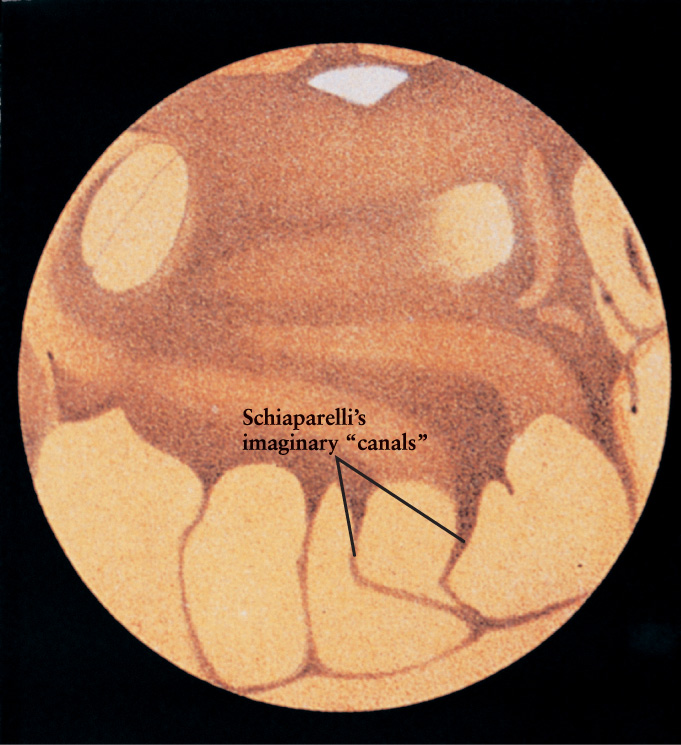
As we saw in Section 11-2, Mars’s axis of rotation is tilted by almost the same angle as Earth’s axis, and so Mars goes through seasons much like those on Earth. Perhaps biased by expectations of Earthlike conditions, in 1877 the Italian astronomer Giovanni Schiaparelli said he was able to see 40 straight-line features crisscrossing the Martian surface (Figure 11-12). He called these dark linear features canali, an Italian word for “channels,” which was soon mistranslated into English as “canals.” The alleged discovery of canals implied that there were intelligent creatures on Mars capable of substantial engineering feats. This speculation helped motivate the American millionaire Percival Lowell to finance a major new observatory near Flagstaff, Arizona, primarily to study Mars. By the end of the nineteenth century, Lowell had reported observations of 160 Martian canals.
Although many astronomers observed Mars, not all saw the canals. In 1894, the American astronomer Edward Barnard, working at Lick Observatory in California, complained that “to save my soul I can’t believe in the canals as Schiaparelli draws them.” But objections by Barnard and others did little to sway the proponents of the canals.
As the nineteenth century drew to a close, speculation about Mars grew more and more fanciful. Perhaps the reddish-brown color of the planet meant that Mars was a desert world, and perhaps the Martian canals were an enormous planetwide irrigation network. From these ideas, it was a small leap to envision Mars as a dying world with canals carrying scarce water from melting polar caps to farmlands near the equator. And of special concern, some suggested that the Martians might be a warlike race who schemed to invade Earth for its abundant resources. (In Roman mythology, Mars was the god of war.) Stories of Martian invasions, from H. G. Wells’s 1898 novel The War of the Worlds down to the present day, all owe their existence to the canali of Schiaparelli.
Observations of Mars: Revealing a Windblown, Cratered World
Another feature of Mars that gained attention is that its surface changes colors on a seasonal cycle. This observation lead to claims that Mars was covered in vegetation that varied seasonally, as happens on Earth. In the 1960s, three American spacecraft flew past Mars and sent back the first close-up pictures of the planet’s surface. (Figure 11-13 shows even better images from a subsequent mission to Mars.) These images showed that the dark surface markings are just different-colored terrain.
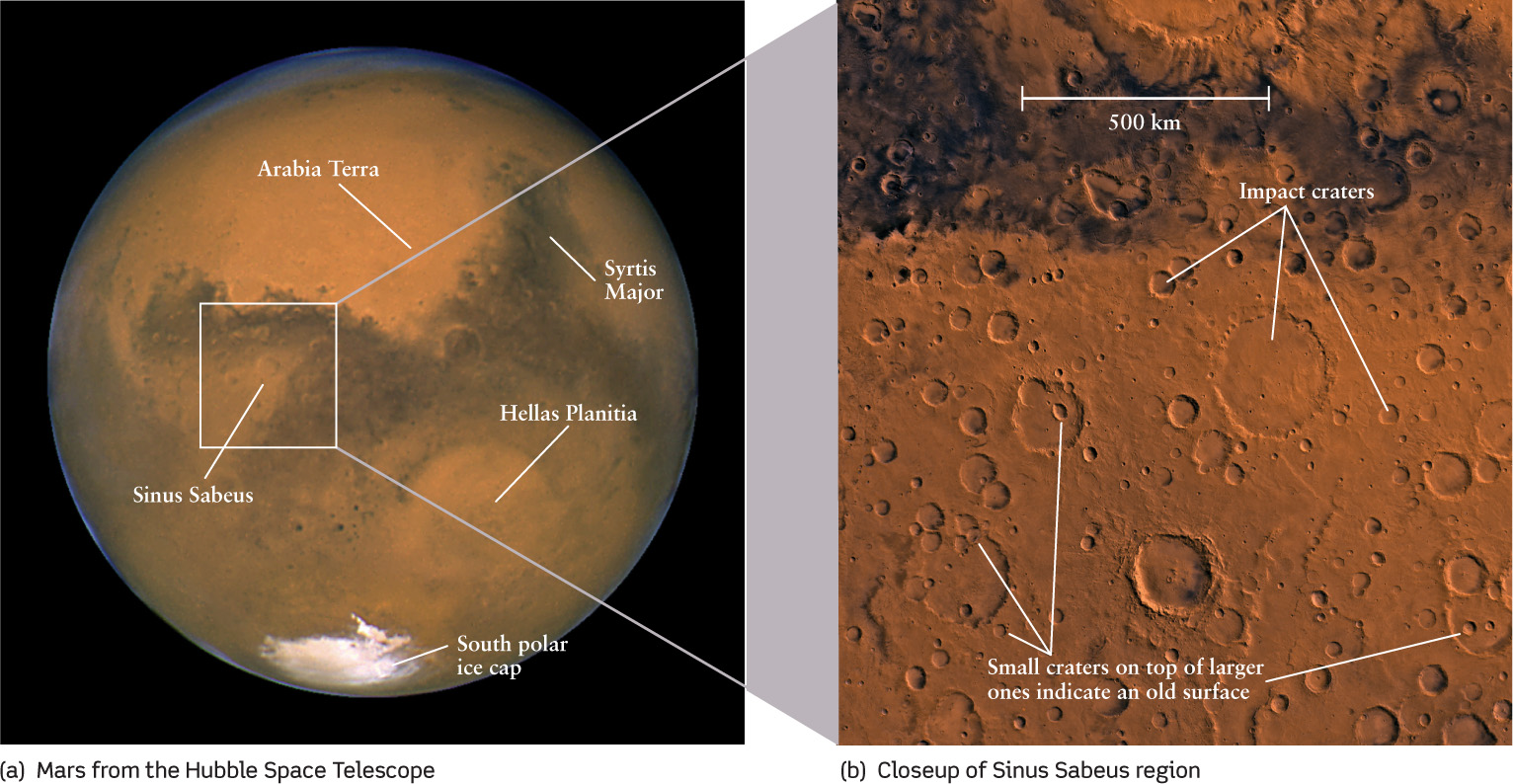
Martian Craters (a) This image, made during the favorable opposition of 2003, shows cratered regions on the side of Mars opposite to that in the image that opens this chapter. Arabia Terra is dotted with numerous flat-bottom craters. Syrtis Major was first identified by Christiaan Huygens in 1659. A single titanic impact carved out Hellas Planitia, which is 5 times the size of Texas. (b) This mosaic of images from the Viking Orbiter 1 and 2 spacecraft shows an extensively cratered region located south of the Martian equator.
The seasonal variations in color can be explained by winds in the Martian atmosphere that blow in different directions in different seasons. These seasonal winds blow fine dust across the Martian surface, producing planetwide dust storms that can be seen from Earth (Figure 11-14). The motion of dust covers some parts of the Martian terrain and exposes others. Thus, Earth observers see large areas of the planet vary from dark to light with the passage of the seasons, mimicking the color changes that would be expected from vegetation.
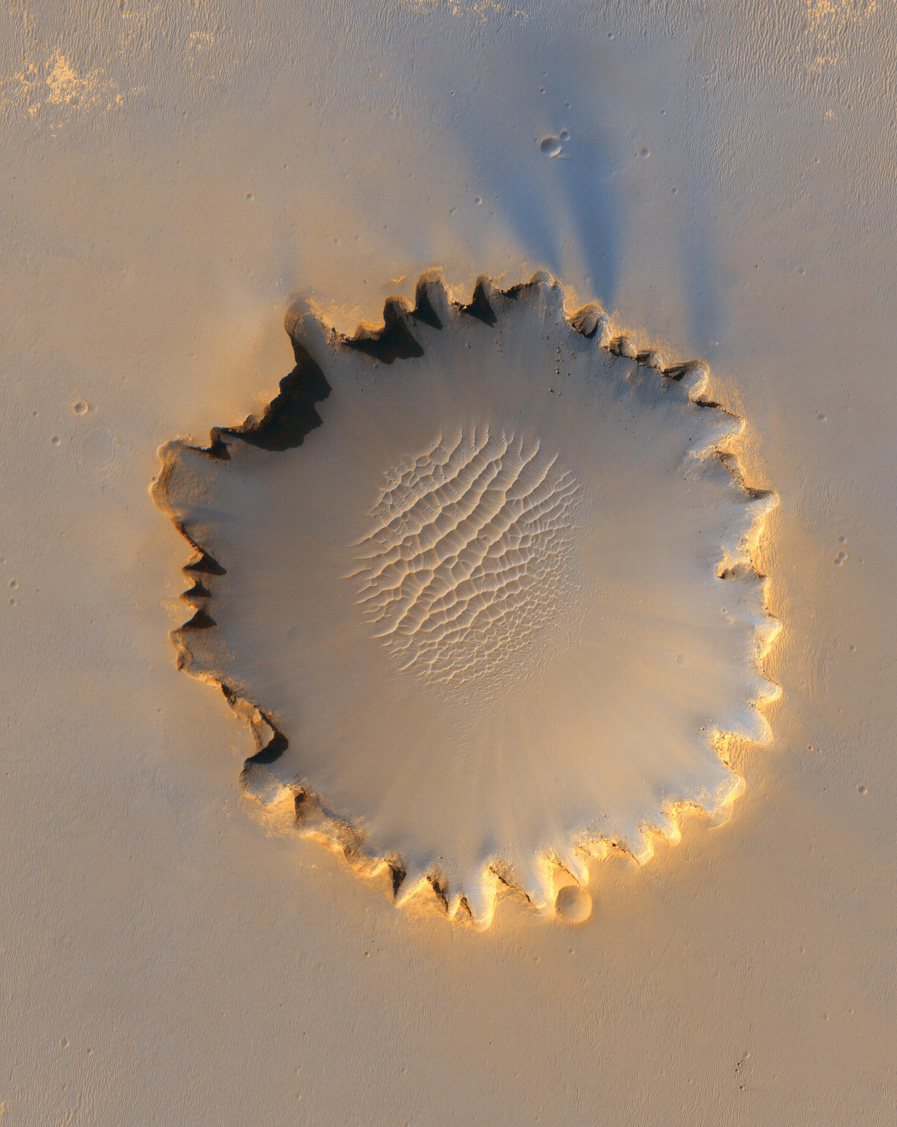
Victoria Crater This crater is about 800 meters wide (half a mile) and about 50 meters deep. The false-coloring of this image brings out sand dunes at the bottom. The robotic Opportunity rover just arrived when this image was taken, barely visible as a speck indicated by the arrow. This image was made by the HiRISE camera aboard the Mars Reconnaissance Orbiter.
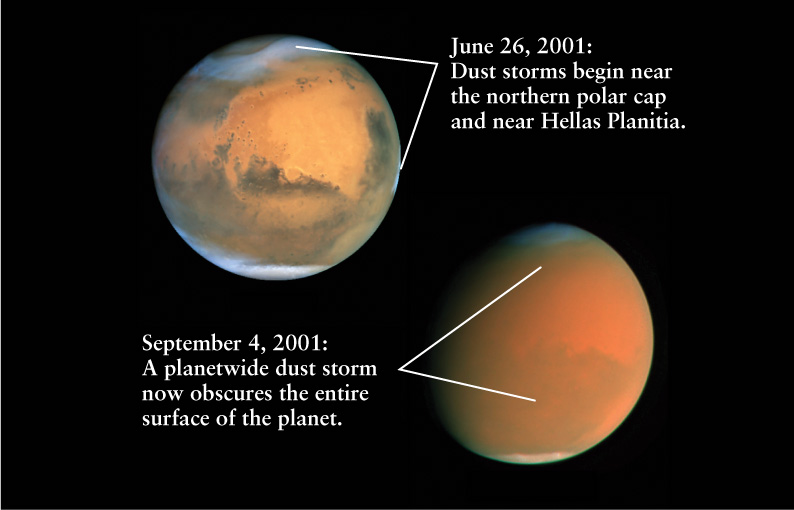
A Martian Dust Storm Dust storms on Mars can expand to cover the entire planet. These Hubble Space Telescope images show a particularly intense storm that took place in 2001, when it was spring in the Martian northern hemisphere and autumn in the southern hemisphere.
Instead of showing irrigation canals and vegetation, the surface of Mars is dry and pockmarked with craters (Figure 11-13b). During the 1960s, scientists were learning that most of the craters on the Moon were formed by interplanetary debris that struck the lunar surface more than 3 billion years ago. The Martian craters, too, are the result of long-ago impacts from space. Since so many craters survive to the present day, at least part of the Martian surface must be extremely ancient (see Section 7-6). The spectacular Victoria Crater is shown in Figure 11-15, with sand dunes at its bottom.
CONCEPT CHECK 11-4
Microwaves are emitted from Venus’s hot surface. What do 1.35-cm microwaves tell us about the presence of water on the surface of Venus and in its thick atmosphere?
1.35-cm microwaves are absorbed by water molecules. If the surface of Venus contained a significant amount of water, it would absorb these wavelengths. The same is true for the Venusian atmosphere. Since microwaves at 1.35 cm were readily detected, there can be little water on or around Venus.